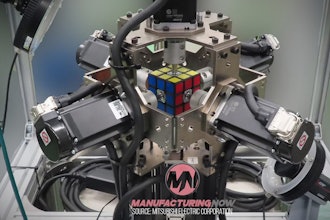Utilizing a data collector/vibration analyzer can help you diagnose machine health. (Photo credit: Ludeca) |
More than 20 years ago someone made the statement, “The vibrations produced in a machine are the best indication of the machine’s health.” This statement still holds true today. Of all the predictive maintenance (PM) technologies, vibration analysis remains the best measure of machine health.
This is true because vibration analysis can alert us to so many different conditions that may indicate potential machine failures. Unbalance, misalignment, bearing faults, resonance, looseness, cavitation and electrical problems are just a few of the many problems that can be detected with vibration analysis.
The data collected in the process of detecting these problems can also be used in determining their root causes. Effective root cause analysis must determine the most cost effective point where actions can prevent or acceptably manage the failure. We can determine this point only if we have adequate information on which to base our conclusions. Vibration analysis is a wonderful tool for supplying much of this information.
The Breakdown
In their book RCM Gateway to World Class Maintenance, Anthony M. Smith and Glenn R. Hinchcliffe state that as many as 50 percent of machine failures are due to human error in maintenance work. In other words, we break things in our attempts to make them better. If this percentage is even close to being accurate, one of the greatest values of vibration analysis is that it helps us work only on the things truly in need of work.
One axiom proven true in studies of PM effectiveness is, “we’re better off to work on nothing than to work on the wrong thing.” Vibration analysis helps us pinpoint the component or part that needs to be addressed in order to prevent or manage the failure. Wholesale repairs, which sometimes introduce more problems than they correct, are made unnecessary.
In addition, what gets measured, gets done: every vibration reading is a measure, and if problems are found, we are alerted to their existence. Work that needs to be addressed is kept in the forefront because machinery constantly tells us about its condition. Vibration analysis can be our ears for deciphering the language of machines, and can help us determine where to focus resources.
A Preventive Approach
Many think of vibration analysis as simply a tool to detect bad bearings, but it is much, much more. Often, conditions (such as loose fasteners, resonant structures, misalignment, unbalance, etc.) which shorten the life of bearings and other components, can be detected, identified, and remedied before they cause a failure. Thus, vibration analysis is not only the most effective method for detecting many potential failures, it also provides us with a means of detecting these potential failures in time to cost effectively manage their consequence or prevent the failures altogether.
For those who seriously want to move from reactive to proactive maintenance, and like the idea of finding and fixing small defects before they become unplanned downtime, this technology is a “must” investment. A program of defect identification and elimination in process equipment is an absolutely necessary part of the holy grail of reliability and increased profitability.
Q&A
If you’re considering whether or not to invest in the equipment and training necessary to begin and maintain an effective vibration condition monitoring program, ask yourself a few questions:
- How often can I tolerate the cost of sudden and unexpected breakdowns?
- Can I afford less than optimal equipment lifetime (early replacement)?
- Do I expect my machines to run for the next X number of hours so we can make marketable product? (You supply the X with your typical planned run time).
If the answer to the last question is yes, how can you expect machines to run, if you don’t know their condition? How do you know they are capable of running the next X number of hours? One point is clear: if you don’t have a measure of the actual condition of your machines, your expectations of them running X number of hours to produce your product is about as lacking in logic as expecting any random direction to get you to your goal destination. All roads do not lead to reliability. If you don’t want to wander from breakdown to breakdown, you must get on the condition monitoring path.
Visual Inspection
Vibration analysis makes it possible to have improved machine and procurement standards, and can be the best tool, in many cases, for determining the quality of vendor repairs and condition of new equipment. |
Vibration analysis also provides for a visual inspection of equipment as the vibration routes are run. A good analyst is always on the lookout for potential failures such as oil leaks, loose fasteners, and broken welds.
One often overlooked benefit of a dynamic vibration analysis/defect elimination program is that a “vibration optimized” machine is a very “green machine.” This machine will use less energy, leak fewer environmentally harmful substances, and require fewer replacement parts. In short, a mature vibration analysis program can actually reduce your carbon footprint.
Uptime And More
Other important value-added properties of vibration analysis include increased machine reliability, increased plant capacity (through increased uptime), and improved machine safety.
Vibration analysis also helps to verify findings of other predictive maintenance tools, reduce costs, reduce manpower needs, reduce product inventories (through optimized scheduling), reduce spare parts inventories, and reduce expedited parts. It can also help to prioritize work by better knowledge of machine condition severity, reduce the need for invasive PMs, and provide a way to manage failures determined by RCM analysis.
Vibration analysis also makes it possible to have improved machine and procurement standards, and can be the best tool, in many cases, for determining the quality of vendor repairs and condition of new equipment.






















